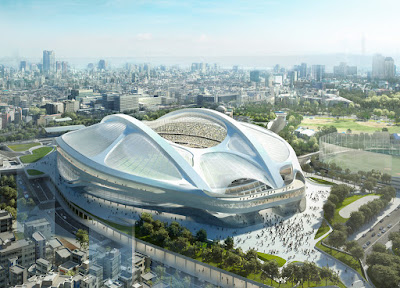The Washington Post had an excellent article regarding taxpayers thoughts on their city being a host city for the Olympic games unless it came at their expense.
Cities have often times had this desire to win a bid to host the Olympic games. The rationale is that it brings a level of prestige to that city and more so, to those that were able to secure the games. The other argument is it’s supposed to make an economic impact in terms of bringing money into the local economy from participants and visitors. It’s no secret though that the entire process is wrought with politics (and by extension, potential corruption).
The costs involved in terms of building up the infrastructure to host the games is one that is shouldered by the tax payers of that city. And those costs can often times escalate as the date of the Olympics nears. Furthermore, the economic impact is normally not a lasting one beyond the weeks leading up to and during the games.
Tokyo will be hosting the summer games in 2020 (the last time they hosted the games was back in 1964). People were naturally ecstatic when the IOC made the announcement back in 2013. The city made itself a candidate for the 2016 summer games but failed in securing the host (public support also was not as high; only a well orchestrated campaign after this failure made both the public and private sector put a higher level of support for the 2020 games). The 2020 bid reused many of the same proposals (including venues) that were made previously but with some further revisions including making the compactness of the vicinity of these venues a key selling point (the majority of events will take place within an 8km circle).
Furthermore, rather than building the Olympic stadium out on reclaimed land in Tokyo Bay (at an estimated cost of $1.3 billion US) near the planned Olympic Village, the 2020 proposal put forth a plan to renovate the existing National Olympic Stadium (which has already been demolished). The term “renovation” naturally tends to be interpreted as costing potentially less (but this isn’t always the case). The following was what ended up being proposed and selected by Japan’s Olympic Committee for use in the bid.

The design was conceived by London based Zaha Hadid Architects (it was selected from 46 other designs by a committee chaired by well known Japanese architect Tadao Ando). The structural design has been derided by several other known Japanese architects over the past 2 years. Regardless of whether the design meets Japanese sensibilities or whether or not it was designed by a Japanese (in this case, not), the problem is that the organizing committee (conveniently) ignored the potential costs involved in this “renovation”.
The above design was prominently displayed during Tokyo’s bid for the games. And unsurprisingly, there wasn’t loud vocalization prior to winning the bid about the costs that would be involved. Even more unsurprising, it wasn’t until after the bid was awarded to Tokyo that the costs were unveiled by the committee overseeing the planning of the 2020 games; roughly $2.5 billion US. That cost supercedes the $1.3 billion cost for the new stadium planned for their prior 2016 bid.
Where the real public outrage came into play is when the central government’s ministry that is in charge of the Olympics (the Ministry of Education, Culture, Sports, Science and Technology) came out and requested that the municipality of Tokyo shoulder ¥50 billion ($420 million) of the costs. Tokyo is of course an interesting case since it is a prefecture (more or less a metropolis), its own city municipality, and also Japan’s capital. The visibility that Tokyo in general receives often times benefits the entire nation; but make no mistake, it’s called host “city” for a reason. And it’s no surprise the city of Tokyo was asked to shoulder a portion of the costs (with that coming from the city’s coffers and by extensions, its taxpayers).
Tadao Ando (the architect overseeing the design selection committee) was quoted as saying he couldn’t understand how the costs escalated so quickly after the selection. That just doesn’t make sense to me since I would like to believe that architects have a pretty good idea as to the estimated construction costs for designs based on their years of experience. And Ando has a fairly extensive portfolio of designs to feign this kind of ignorance. Furthermore, someone in his position should’ve raised the notion of costs (as supposedly outlined by Zaha Hadid Architects to the JSC) as a matter of transparency.
For contrast sakes, Beijing’s National Stadium (aka Bird’s Nest) cost around $570 million and is now considered a relic and museum with no regular tenant and an annual $11 million yearly price tag to maintain. Like many Olympic venues/infrastructure, the original costs are never recouped with taxpayers footing the bill for the long haul.
The city is vying for the 2022 Winter games and plans to reuse this stadium and a few other facilities (like the aquatic center for the ice skating rink) but they still won’t recover that investment since they are also currently pouring billions into new infrastructure in the regions where other events will be held (basically the mountainous areas). In some host cities though, everything is left to fall into ruins. With the proposed price tag of this venue, even a city like Tokyo would not likely recoup those costs from reusing the stadium for sports, concerts, and as a tourist attraction.
What’s more, anyone who is familiar with the area of the current Olympic Stadium site (in Aoyama just south of Shinjuku Gyoen), knows how the above design would just look TOTALLY out of place with its surroundings there.
The stadium has basically turned into a growing fiasco typical of politics in general; lacking transparency, promising the world, conveniently ignoring realistic issues such as time and costs, and then trying to backtrack on those promises once the proponents have gotten their way (in the case of politics, elected into office). One of the other key promises was for this new stadium to be ready for the 2019 World Rugby Tournament.
With all of this coming out into the open, public approval of the project has plummeted and required Japanese Prime Minister Shinzo Abe to come out and say that the proposed stadium design will be scrapped, and a new design commissioned (this after several petitions and design changes that have reduced its scale). Additionally, this also means the new venue won’t be ready in time for the 2019 World Rugby Tournament (yet another broken promise).
Some of the most visually striking designs from the 1964 Olympics were designed by Japanese architects. And the country today has some very well versed architects who have not only followed in the footsteps of the likes of Kenzo Tange (the designer of the Yoyogi National Gymnasium, Fuji TV Building, Tokyo Metropolitan Government Building, Mode Gakuen Cocoon Tower to name a few), but also made a name of themselves with their own design sensibilities.
This entire fiasco makes the Japanese central government (under Shinzo Abe’s “leadership”) look incredibly “incompetent” though (especially when the organizing committees at the national and city level) failed to raise the cost issue until after the winning bid was secured. I have incompetent in quotes because I’m not ruling out corruption. In that case, my question is exactly who is getting kickbacks of sorts and how much money spent to date isn’t going to be recouped? It also puts into perspective the reconstruction efforts in Tohoku where this kind of money would’ve been better spent dealing with the country’s real issues in that region after the 2011 earthquake, tsunami, and nuclear disaster.



